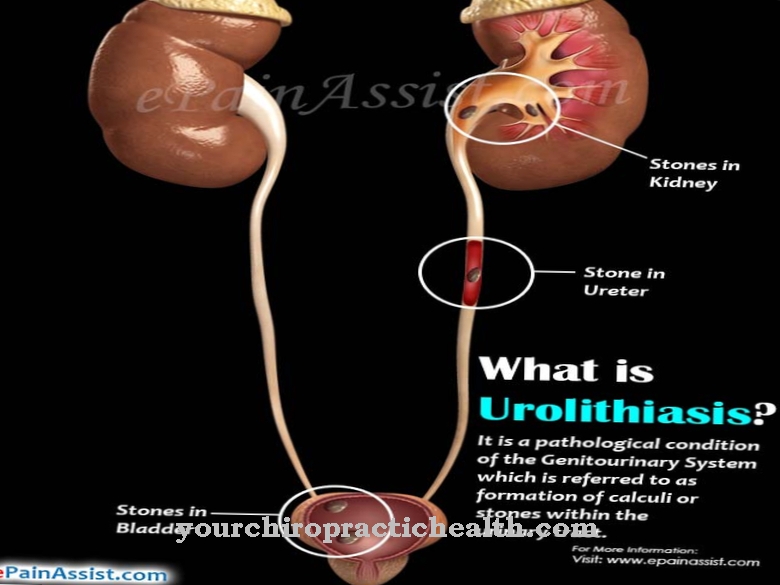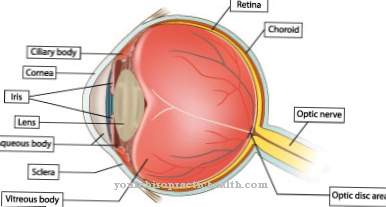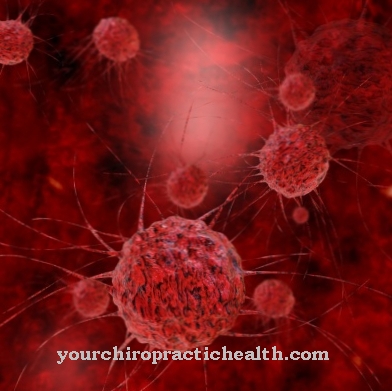Under Köhler's disease I is a very rare, aseptic necrosis of the scaphoid bone. Köhler's disease I occurs mainly in boys who are between three and eight years old. However, many doctors do not make the diagnosis until later in life; In many cases, osteoarthritis has already formed in the tarsus.
What is Köhler's disease I?

© falco47 - stock.adobe.com
In advance there is Köhler's disease I as well as Köhler's disease II; While Köhler's disease I represents necrosis of the scaphoid bone, a tarsal bone, in the context of Köhler's disease II the metatarsal bone (second, third or fourth ray) dies.
Characteristic of Köhler's disease is the spontaneous death or the spontaneous formation of necrosis. This means that neither an infection nor any other external influence is responsible for the necrosis to develop.
So far it is unclear what causes the death. The disease becomes noticeable through pain in the foot, without anything being externally recognizable.
The doctor can make a diagnosis using x-rays.
causes
The reasons why Köhler I disease develop has not yet been clarified. However, many experts have been discussing possible development models for years or are of the opinion that they have found favorable factors that could cause Köhler's disease. It is noticeable that Köhler's disease I always occurs when the person affected shows a so-called growth spurt.
For this reason, it is reasonable to assume that the ossification of the skeleton sometimes has problems and cannot keep up with growth. Because of this, bone instability develops in the affected region.
Another theory is based on similar diseases that are sometimes characterized by a circulatory disorder. However, the fact that insufficient blood flow only occurs in advanced age or adulthood speaks against this assumption, so that this factor is not present in the context of Köhler's disease I.
Furthermore, doctors are of the opinion that overloading the bone can also be the decisive reason for Köhler's disease. For what reason only children, and preferably boys, fall ill, could not be answered within the framework of that theory.
Symptoms, ailments & signs
The first sign is pain. The affected person complains of sudden pain as part of the exertion (for example when walking or running). However, external injuries or changes to the foot cannot be detected.
Patients also complain of pain when pressure is applied to the scaphoid bone. If the foot is not spared, a swelling can occur in the region of the scaphoid, which also suggests that it could be Koehler I disease.
Diagnosis & course of disease
If there is a suspicion that it is Koehler's disease, a diagnosis must be confirmed in addition to the so-called suspected diagnosis. The diagnosis is secured by means of an X-ray. The affected foot is x-rayed from the side and from above. If Köhler's disease is actually present, the doctor can detect a narrowing and at the same time a compression of the navicular bone.
Sometimes it can already be postponed, which is another indication that there is a high probability that Koehler I disease is present. No other examinations are necessary. In order to confirm the diagnosis, however, the doctor must ensure that he can definitely rule out Köhler's disease.
Köhler's disease I has a relatively good prognosis. While the healing process is tedious and takes several years, it is promising. The physician predominantly opts for conservative therapy; Operations are only necessary in the rarest of cases. Damage caused by Köhler I disease usually heals - without any long-term effects.
Complications
The patient's first and foremost pain is very severe pain due to Köhler's disease. These pains mainly occur during stress and can thus significantly limit the everyday life of the person concerned. As a rule, the patients suffer from pain especially when walking or running, although this can often also occur in the form of pain at rest.
Pain at rest at night can lead to sleep problems and possibly depression. Likewise, no injuries or other peculiarities can be detected from the outside. Not infrequently, Köhler's disease I also leads to severe swellings in the affected regions. These can occur if the legs continue to be strained even when they are in pain.
As a rule, the quality of life of the person affected is significantly reduced by this disease. The everyday life of the patient is also prevented, so that physically strenuous activities or sports can no longer be carried out. Especially in children, Köhler's disease can lead to restrictions in development.
Treatment of the disease does not lead to further complications. Physiotherapy measures in particular are necessary to alleviate the symptoms. However, a completely positive course of the disease cannot be guaranteed in every case.
When should you go to the doctor?
The risk group for Köhler's disease I consists of boys between the ages of three and eight. Although the correct diagnosis is often only made a few years after the first signs of a health irregularity, a doctor should be consulted as soon as the initial symptoms appear. If the children complain of pain in the bones or when moving, a doctor should be consulted to clarify the symptoms. There is a risk of confusion with the natural growth pain. For this reason, it is particularly important to initiate a careful investigation as soon as a discrepancy is suspected in a direct comparison with children of the same age.
If the child is particularly tearful or allegedly grouchy, a check-up visit with a doctor is necessary. A doctor is required if there are any particularities in the movement sequences or general motor skills. A reduced level of physical performance, premature exhaustion or poor resilience in the child must be examined and clarified. If you feel instability in your bones, limp or show signs of circulatory disorder, you should see a doctor. Particularly pale skin in the affected area or cold feet can indicate a health problem. If they continue unabated over a longer period of time, it is advisable to consult a doctor.
Treatment & Therapy
If the physician diagnoses Köhler's disease I, various therapy options are available to him. The physician predominantly opts for conservative treatment. The leg should therefore often be spared; Deposits can provide relief. Sometimes the leg can also be immobilized using a plaster cast. Physiotherapy treatments are particularly important.
This is because any tension, muscle hardening or other stiffening can be prevented.Massages or targeted therapies that deal with relaxation and movement of the foot help to ensure that the course of the disease can be shaped positively and that no long-term effects are to be expected at the end of the healing process.
With hyperbaric oxygen therapy, the doctor can regulate the ambient pressure for the patient - using the hyperbaric chamber - and supply 100 percent oxygen. Records have shown that patients who were diagnosed with Köhler's disease in the early stages benefited from the treatment.
Hyperbaric oxygen therapy is also often used as part of physiotherapeutic treatment and is one of the conservative treatment methods. Operations are seldom necessary, but are necessary if conservative treatments do not bring the desired success or Koehler I disease could only be diagnosed at a later stage.
The medic tries to stiffen the joint; this variant becomes ripe when an advanced osteoarthritis has already developed, which causes enormous pain for the patient. But there are also surgical measures that can be taken at the beginning of Köhler's disease.
The doctor decides to use the so-called Pridie drilling. This means that the doctor drills into the affected bone and thus initiates revascularization. This method is seldom carried out and if it is, then only in the early stages of Köhler's disease.
You can find your medication here
➔ Medicines for painOutlook & forecast
Köhler's disease can usually be treated successfully. There are scientifically based treatments available that allow the symptoms to be completely eliminated. However, the healing process can take a long time. The spectrum of treatment ranges from months to years. It is recognized that starting treatment early will produce the best results. On the other hand, those who do not undergo treatment or do not attach importance to typical symptoms risk developing osteoarthritis in adulthood. This results in instabilities and restricted mobility that put a heavy strain on everyday life.
The disease is mostly diagnosed in male children. At this age, the body is still growing. Relief of the metatarsus and other conservative procedures are usually sufficient to achieve complete healing. During this time the body has a tremendous ability to heal itself, which means that an operation is not necessary.
This results in a favorable prognosis for Köhler's disease I. If symptoms persist in rare cases, these can be almost eliminated with aids. Those affected do not have to suffer any significant restrictions in their quality of life. A shortening of the lifespan is not given by Köhler's disease I.
prevention
Preventive measures are not known, as no causes have yet been found why Koehler's disease I develops.
Aftercare
In many cases, the measures and the possibilities of direct follow-up care for Köhler's disease are significantly limited. Sometimes it is not even available to those affected due to the severity of the disease. For this reason, patients should ideally see a doctor very early and initiate treatment so that no further complaints and complications can occur.
Self-healing cannot occur, so treatment by a doctor is always necessary. Due to the genetic origin of Köhler's disease, those affected should have a genetic examination and advice carried out if they want to have children in order to prevent the disease from recurring in their descendants. In most cases, patients with the disease are dependent on physiotherapy and physiotherapy to alleviate the symptoms.
Many of the exercises from such therapies can be repeated in your own home, which speeds up the treatment. It is also not uncommon for the person concerned to support his or her family in everyday life. Depression and other mental upsets can also be prevented. The disease Köhler I usually does not reduce the life expectancy of the patient.
You can do that yourself
In the case of the disease, the person affected has little leeway and options for self-help. In everyday life, the physical limits should be perceived and adhered to. A sudden decrease in physical performance can occur, especially during the period of growth spurt, which must be taken into account. In the event of pain and discomfort, the organism should be spared. Adequate rest phases are to be observed so that the strength can be regenerated.
The footwear must be adapted to the size of the foot. It shouldn't be too small or too big. The wearing of high heels is to be avoided during the entire growth and development period of the child, as this can increase the discomfort. Sturdy footwear, the size of which is checked and adjusted at regular intervals, is important and necessary. The body weight of the person concerned should be in the normal range of the BMI. Obesity should be avoided as this has a negative impact on the development of bone structure and joints. This can lead to postural damage or discomfort that can impair wellbeing.
If you experience pain at rest or if you experience persistent pain, you should see a doctor, as medical care is required. Competitive sports or the practice of extreme sports are prohibited. They represent an additional burden that has a negative effect on the course of the disease.

























.jpg)


